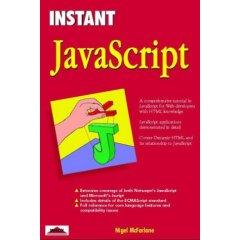| 2020ok Directory of FREE Online Books and FREE eBooks |
Free eBooks > Computers & Internet > Web Development > Internet Commerce > Web Site Design > Instant Javascript
Instant Javascriptby Nigel Mcfarlane  Download Book (Respecting the intellectual property of others is utmost important to us, we make every effort to make sure we only link to legitimate sites, such as those sites owned by authors and publishers. If you have any questions about these links, please contact us.) link 1 About Book Amazon.com JavaScript is a powerful way to extend HTML content and work with Java applets, but developing with this language can be tricky. With this one-volume reference, you can begin using scripts within Web pages and also learn some of JavaScript's high-end features. Early sections treat JavaScript as just another programming language, detailing data types, operators, and basic keywords. Then the book turns to the nuts and bolts of script development inside Web pages, featuring advanced topics you might not find elsewhere, such as the possibility of running JavaScript scripts on the server. Further chapters explain how to get to browser objects from JavaScript, describing windows, forms, and event handling. There is also a good introduction to manipulating Java applets and Netscape plug-ins (such as Shockwave) with JavaScript. But some of the best chapters teach you how to use browser cookies within Java and offer debugging tips from the author. (JavaScript is legendarily difficult to debug, and the author has a number of potentially helpful suggestions here.) Final sections show JavaScript at work with dynamic HTML. The reference material at the end of Instant JavaScript gives a handy listing of JavaScript fundamentals and HTML tags, making this book useful as both a tutorial and a place where JavaScript developers can get answers.
Client-side JavaScript, with its timing mechanisms and access to host objects that reflect a document's content is absolutely crucial for Dynamic HTML. Viewed from the JavaScript perspective, it is the script writer that creates dynamic behavior in a document that is otherwise just an inactive load of HTML. As is the case for the Java language, Dynamic HTML is a subject rich in information that really requires a book of its own. Only the most important features are touched on here. The term Dynamic HTML is somewhat vague. In a general, hand-waving sense, it means any HTML document in a browser that exploits one or more specific technical features in order to create one or more specific visual effects. From a practical point of view, that is hardly a useful description. Defined as a technology Dynamic HTML can be viewed as an evolutionary improvement in browsers, rather than an entirely new, alien technology. Related Free eBooks | Related Tags |












SEND A COMMENT
PLEASE READ: All comments must be approved before appearing in the thread; time and space constraints prevent all comments from appearing. We will only approve comments that are directly related to the article, use appropriate language and are not attacking the comments of others.